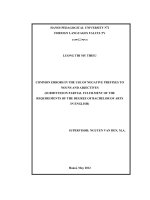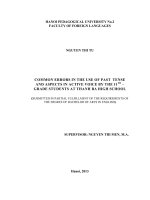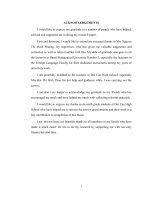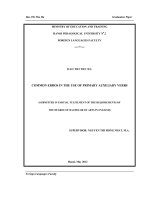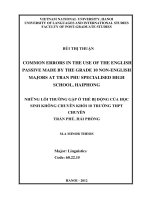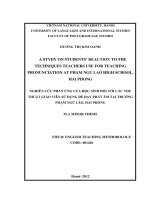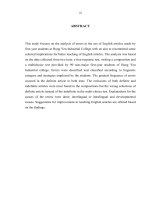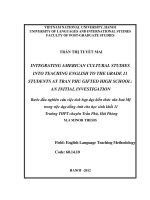Common errors in the use of the English passive made by the grade 10 Non-English Majors at Tran Phu Specialised High School, Hai Phong
Bạn đang xem bản rút gọn của tài liệu. Xem và tải ngay bản đầy đủ của tài liệu tại đây (123.12 KB, 3 trang )
Common errors in the use of the English passive
made by the grade 10 Non-English Majors at
Tran Phu Specialised High School, Hai Phong
Bùi Thị Thuận
Trường Đại học Ngoại ngữ
Luận văn Thạc sĩ ngành: English Linguistics; Mã số: 60 22 15
Người hướng dẫn: M.A. Nguyễn Huyền Minh
Năm bảo vệ: 2012
Abstract. It is irrefutable that English passive voice is a characteristic feature of English
and it is at the same time so problematic to most learners owing to its complexity,
variety in forms and exceptions. Due to its importance, this study aims at analyzing
typical errors made by the students at Tran Phu Specialised High School, Hai Phong
City in using the English passive with the hope to improve the context of teaching and
learning this grammatical aspect at the school. In this study, a review of the English
passive voice is presented from simple to complex matters in order to help students
attain systematic and relatively sufficient knowledge of the English passive. Besides, it
also discusses some differences between the English passive voice and its so – called
Vietnamese equivalent as they are said to be the basic reason for most errors in using
English passive sentences. Above all, the focus of this paper is on giving realistic
strategies for the students to overcome the common errors and making the teachers
prepared to anticipate most probable problems that might arise so that they can be
confident to assist their students.
Keywords. Thể bị động; Tiếng Anh; Phương pháp giảng dạy; Ngữ pháp
Content
I. Rationale of the study
According to statistics of recent studies, people who master English will see greater
possibilities of success in doing research, getting promotion, and doing business. They also
confirm the relationship between English competence and high salary or increased trade.
Accordingly, the importance of English is undeniable because it has become the most popular
language in all over the world. This is the reason why English is now an obligatory subject in
every high school in Vietnam.
In fact, many students are finding this subject more difficult than they used to think. A lack
of grammar can be one of major obstacles to mastering this second language. There is an
irrefutable fact that grammar is an integral part of every language, and English grammar is not an
exception. How would you study other specific fields in English without mastering grammar?
English grammar includes many beautiful and unique aspects which we cannot find in other
languages. To Vietnamese learners, English grammar sometimes makes them confused due to
the differences between English and our mother–tongue. As a result, they have a lot of
difficulties in communicating, especially in reading and writing in English.
The passive voice is considered to be one of the hardest grammatical items for Vietnamese
learners to master. Although there are a lot of pages, books, chapters which have been written
about the passive voice, many students of English still have trouble explaining its usage in
understandable ways. In my experience in teaching English at Tran Phu Specialised High School
in Hai Phong City, students often make common errors in using passive voice and causes of
these errors have not been discovered yet.
The analysis of students’ errors is of great importance in teaching English. It helps teachers
identify students’ strategies of language learning and their level of proficiency so that teachers
can find out suitable ways to improve current situations.
These are the reasons why I have decided to carry out a small study on common errors in the
use of the English passive made by the grade 10 non-English major students at Tran Phu
Specialised High School.
II. Objectives of the study:
The study is aimed at firstly achieving deeper understanding of English passive voice, and
above all, figuring out typical errors made by the students at Tran Phu Specialized High School
in using passive voice. Besides, the thesis is to find out causes of the typical errors in using
passive voice and working out solutions to teaching students passive voice effectively.
Hence, the research is to answer the following questions:
+ What are the typical errors made by non – English majors at Tran Phu Specialized High
School?
+ What are probable causes for these errors?
+ What are possible solutions to help the students overcome these errors?
III. Scope of the study:
The study is focused on the passive voice. However, it is not my ambition to cover every
issue of the passive voice. Within this small thesis, I desire to give readers some aspects of
passive voice: a description of the passive voice sentence, uses, passive transformation
constraints, and the formation of passive voice. A comparison between English passive sentences
and their Vietnamese equivalents is also mentioned.
Moreover, second language learners are various and different in the way of making
errors. However, because of limited size, the study will concentrate on giving an analysis of
errors made by only 70 students from two non-major classes at Tran Phu Specialised High
School.
IV. Methods of the study:
This study is a quantitative survey research. In fact, a combination of data instruments is
employed in an attempt to attain all the objectives above. All the theory is attested by the exact
data collected from a written test and a questionnaire for students which is presented in the later
parts of the study. From the analysis of the data, the problems will be found and the solutions
will be given.
V. Organization of the study:
The study consists of three parts: Introduction, Development and Conclusion.
- Part I (Introduction) shows the rationale, the objectives, the scope, the methods and the
organization of the study.
- Part II (Development) includes three chapters. Chapter I reviews the literature related to
English passive voice and error analysis. Chapter II provides the methodology which takes a
closer look at the subjects, the background, and the methods in use. Chapter III analyzes actual
errors made by the subjects. This chapter also discusses the causes of these errors and suggests
some solutions to the improvement of teaching this grammatical item.
- Part III (Conclusion) summarizes the content of the research and gives some suggestions
for further study.
References
1. Alexander, L.G. Longman English Grammar Practice. Longman group Limited,
London,1998.
2. Brown, H. Douglas, 1987. Principles of Language learning and Teaching, Prentice Hall
Regents.
3. Brown, H. Douglas, 1980. Principles of Language learning and Teaching, Prentice Hall
Regents.
4. Corder, S. P., 1967. The significance of Learners’ Errors in IRAL, 5, No.4.
5. Corder, S.1971. Introducing applied linguistics. Penguin.
6. Ellis, R.1994. The study of second language acquisition. Oxford University Press.
7. Ellis, R.1997. The study of second language acquisition. Oxford University Press.
8. Ellis, R. 1985. Understanding Second Language Acquisition. Oxford University Press.
9. Gordon, E.M. A grammar of present day English. Mosco Vyssgja Skola, 1982.
10. Illinois, R. Composition and Grammar. Laidlaw brothers Published, 1985.
11. Lennon, P, 1991. Error: some problems of definition and identification, in Applied
Linguistic, vol. 12, num.2, Oxford.
12. Michael Vince and Peter Sunderland. Advanced Language Practice. Macmillan
Publishers Limited, 2003.
13. Micheal Swan. Practical English Usage (Third Edition). Oxford University Press, 2005.
14. Quirk, R and S. Greenbaum and G.Leech and J. Svartrick. A grammar of contemporary
English. Longman group Limited, London, 1972.
15. Richards, J.C. et al.1992. Dictionary of language teaching and applied linguistics.
Essex, Longman.
16. Richard, Jack C., 1971. A Non – contrastive Approach to Error Analysis. English
Language Teaching, 25, No. 3.
17. Richard, Jack C., and Gloria P. Sampson, 1974. The Study of learner English. London:
Longman.
18. Randolph Quirk, Sidney Greenbaum, Geoffrey Leech & Jan Svartvik, 1985. A
comprehensive grammar of the English language. Longman group limited.
19. Stenson, Nancy, 1974. Induced Errors. Newbury House Publishers.
Websites:
1.
2.
